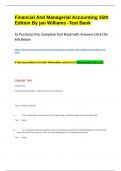Exam (elaborations)
Financial And Managerial Accounting 15th Edition By jan Williams -Test Bank
- Course
- Institution
Financial And Managerial Accounting 15th Edition By jan Williams -Test Bank To Purchase this Complete Test Bank with Answers Click the link Below bank/ If face any problem or Further information contact us At Sample Test Chapter 03 The Accounting Cycle: Capturing Economic Events...
[Show more]



